The relationship between content marketing and SEO is, at first glance, a love story for the ages. Two teams in constant thrall to one another:
- Search throws up big questions that need answers
- Content provides big answers to these questions
And their union delivers sustainable, measurable results upon which every marketer dotes.
But look beyond that first glance, usually and relevantly a Google search, and you’ll unearth some tricky questions that this post looks to answer (sprinkled with the odd dab of meta).
Is SEO and content marketing integration so tight?
Ask Google and it dutifully throws up the two peas in a pod argument. But this line of thinking is led by the ever-industrious, occasionally caustic and always whip-smart search network. Rarely the other way round. Why’s that? Well, SEOs are:
- Much better at getting rankings (not a debate)
- More dependent on the relationship for results (open for debate)
The integration on the content marketing side of the affair isn’t so clear.
This, in part, comes from a limited understanding of the technical challenges of search. While that’s not the venn we want to explore, we know it’s not a search marketer’s sole raison d’etre to research ideas for content writers to smash out the park. Far from it.
And content marketing’s relationship with search isn’t monogamous. It flirts with lots of powerful and well-funded suitors: positioning, branding, UX, creatives, sales teams, analysts, social media and syndication to name but a few. You’ll rarely find search at the top of that list and, alarmingly, sometimes missed off the dance card completely.
Fancy giving it a Facebook relationship status? It’s complicated.
Do content marketers underestimate search?
Not wilfully. They like high-intent visits and conversions. Who doesn’t? But many see it as a necessary evil rather than an essential good.
The personification of Google as a creative-suppressing martinet lingers: use this exact phrase, write headlines like this, write this many words, put it at the front, use hyphens…Aaaarrgghh!!
All these rules to satisfy one master make it hard to please the rest. And it’s no surprise search falls out of favour when the “rest” turn up in numbers promising fun and flexibility.
But this stereotype is outdated and underestimates the potential of future Google. And this is where content marketers risk missing a trick.
What does effective SEO and content marketing look like?
Expert, authoritative and trustworthy (EAT) content, with a good technical set up, is rewarded way more than hamfisted attempts to game the system. An evolving algorithm, while far from perfect, asks you to think less about search tactics and more about marketing strategy.
As a rule you’ll see more crap content used in tactical, short-term lead generation actions. Conversely, strong search performance is an outcome of strategic, long-term content-powered demand generation systems.
You shouldn’t look at search as a line item: bash out a few blogs; pat yourself on the back. You should consider search as a key factor in every B2B marketing objective.
Want an example of what we mean? Let’s look at how one well known B2B marketing agency – in B2B marketing circles anyway – puts this thinking into practice. In time-honoured Velocity tradition, we’re going “project open robe” one more time.
A Live B2B SEO and Content Case Study
About four years ago we knew our world was changing. The core business, built on strategic messaging and content creation, remained strong. But we knew the market, partly through search trends, was evolving: it wanted more digital creative and a focus on performance over production.
We needed to evolve our positioning. Doug and team obliged as usual.
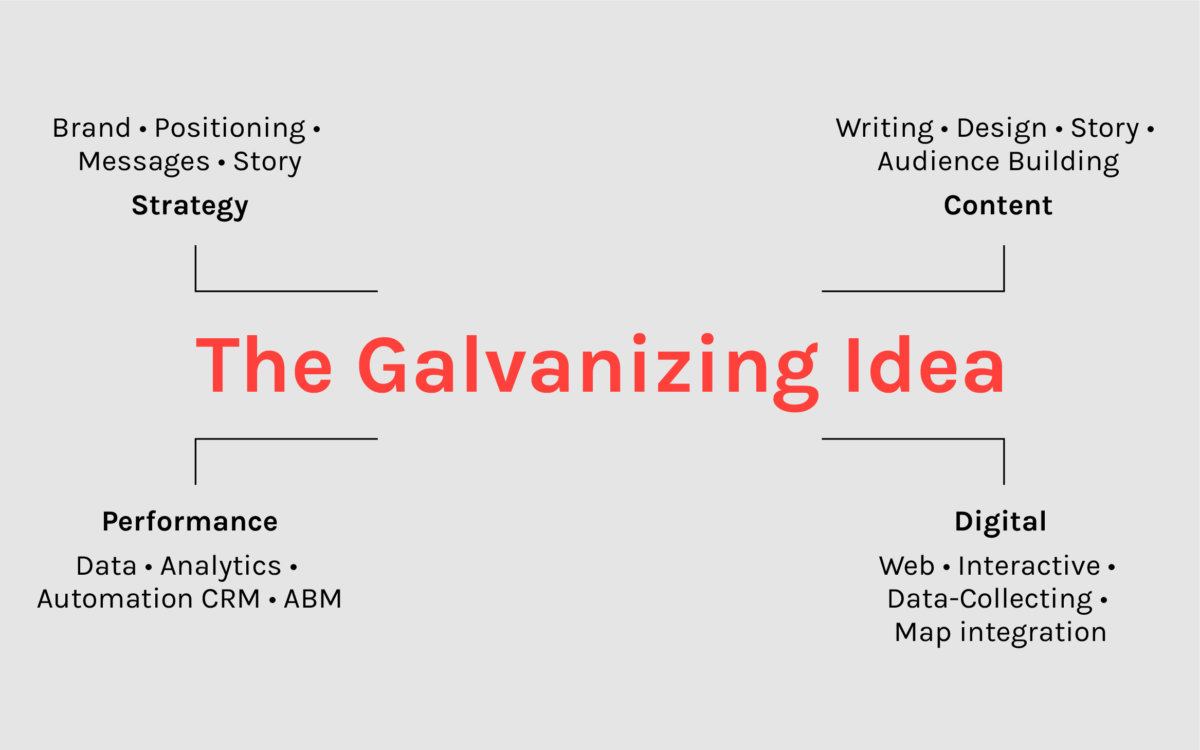
But just because you say you’ve changed doesn’t mean your market has noticed, cares or believes you. We needed content (you’re reading some now) to prove the substance of our new position.
And we needed it to succeed on SERPs where, at the time, around 8,000 people each month were clicking through to form first and lasting impressions about what we do.
How do we integrate SEO and Content?
Our first goal was to research three questions:
- What does Google think we do?
- What would we like Google to think we do?
- What’s the investment required to make the transition?
Google had been “eating up” our core business marketing content for years. It values our contribution to this established search entity. But there wasn’t much to show in the new digital or performance marketing capabilities in our strategic offering. As expected.
We needed a strategy to bridge that gap.
Identifying Search Clusters
First we looked at thematic clusters to reflect our expertise on data and web analytics, research, media programmes, search engine marketing, marketing automation and account based marketing. Lots of big search topics in there.
But you can’t (without boundless output and optimism) expect to become an overnight authority on all these things. So we focused on where the relationship between our established and evolving skills are strongest.
These relationships have previously taken us to search clusters like content marketing and demand generation or B2B marketing and performance metrics. They represent our strategic position, area of expertise and best chance of search success.
And now we’re, literally, focusing on the relationship between content marketing and B2B SEO.
Establishing Search Cluster Relevance
But just because a cluster sounds good doesn’t mean it’s a solid investment. So we run them through two tests: the first to check if it’s suitable, the second to see what we’ve already done.
Suitability
- Fit – How important is the cluster?
- Focus – Is it clear to only our industry?
- Volume – Are there enough searches?
- Competition – Can we win?
- Trend – Is it growing?
- Status – Are we already playing here?
Actions
- Optimisation – Have we done the basics?
- Structure – Is it in our architecture?
- SERP Features – Have we targeted them?
- Small Content – Do we have any?
- Big Content – Have we done any?
- Backlinks – Have we got any?
We score each variable out of five. You can see good scores in the suitability graph below, but with stiff competition from savvy players, while the action graph shows we’ve limited content in play but loads of scope to improve.
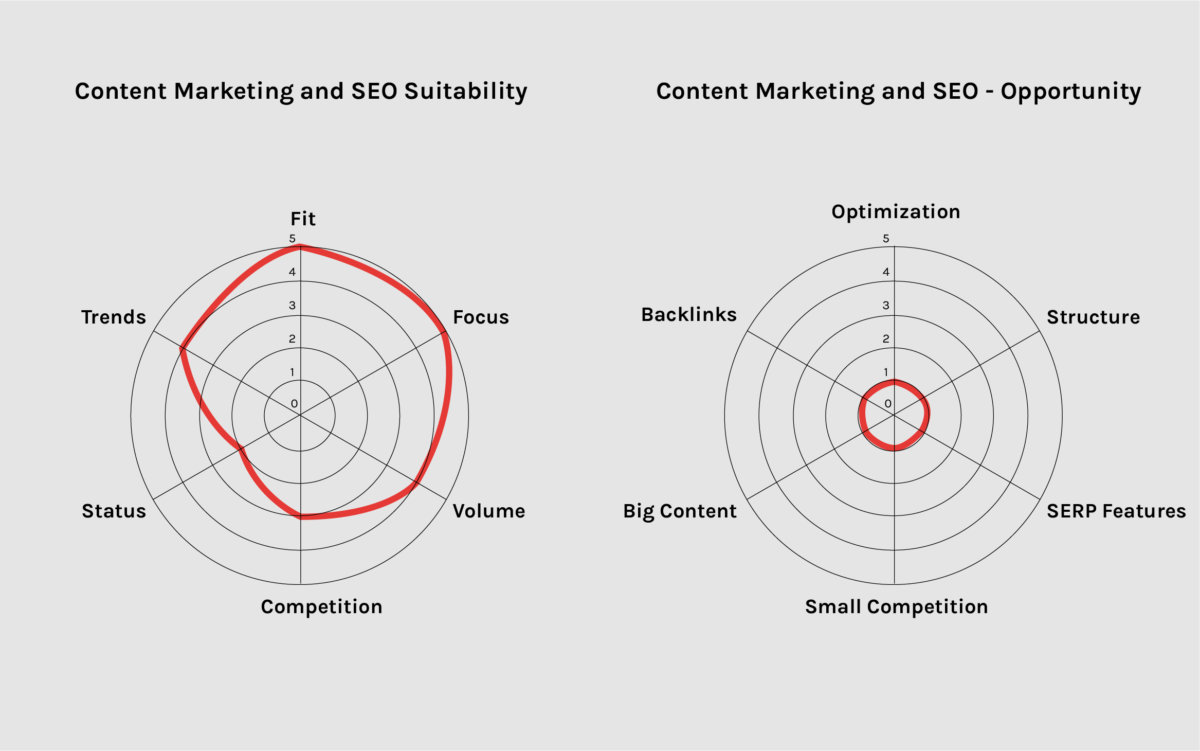
We decided that “content marketing and seo” is a winner but just upgrading some existing material wouldn’t do the job. This article felt like the minimum requirement to be competitive (and it may not be enough).
Identifying Relevant Search Queries
Next we looked for evidence of queries that we’re qualified to answer (earlier in this post). We looked at:
- What is the relationship between content marketing and SEO?
- How do SEO and content marketing integrate?
- What’s effective SEO and content marketing?
Yep, we’re well placed to answer these questions. And by looking at it from the content marketing side we would bring a unique perspective.
Setting Search Cluster Metric
The final step is to set our metrics. We like to focus on four core KPIs (not all restricted to search) for this piece.
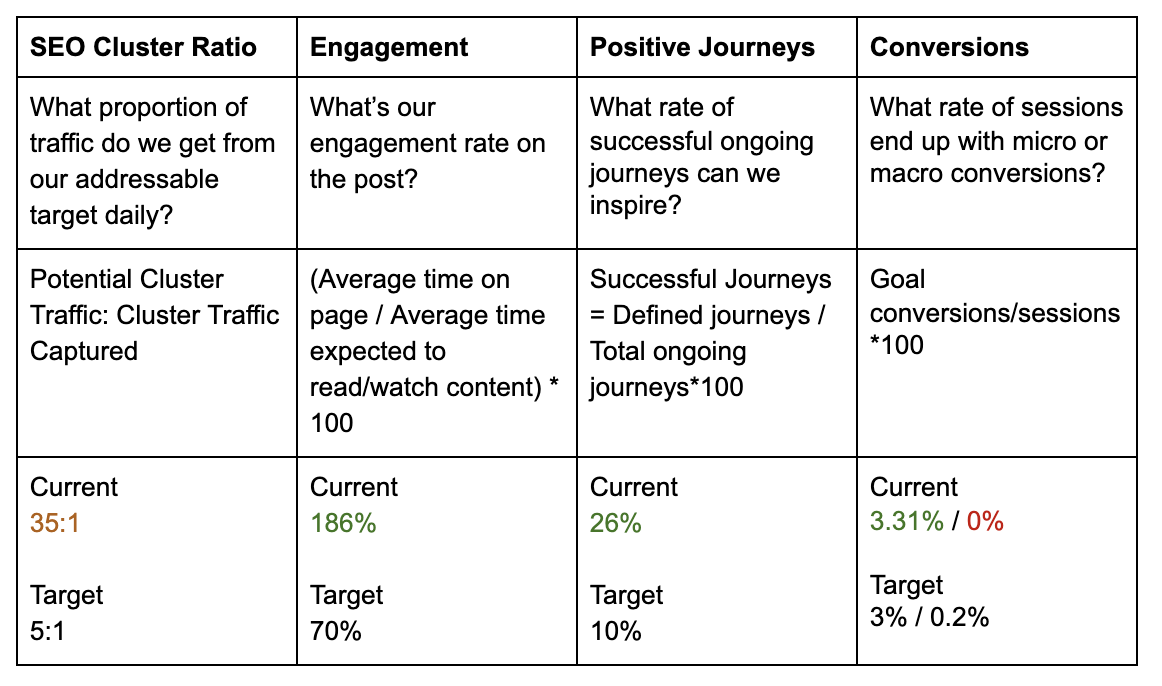
Current Result Summary
These results listed were correct on 7th Oct 2020, 64 days since the post went live. We’re now starting to see an impact on SERPs from our SEMRush data tracking and search console data. Our content marketing metrics still look better than our search metrics but they’re both heading in the right direction. But we’re still to see the vanity figures turn to significant traffic.

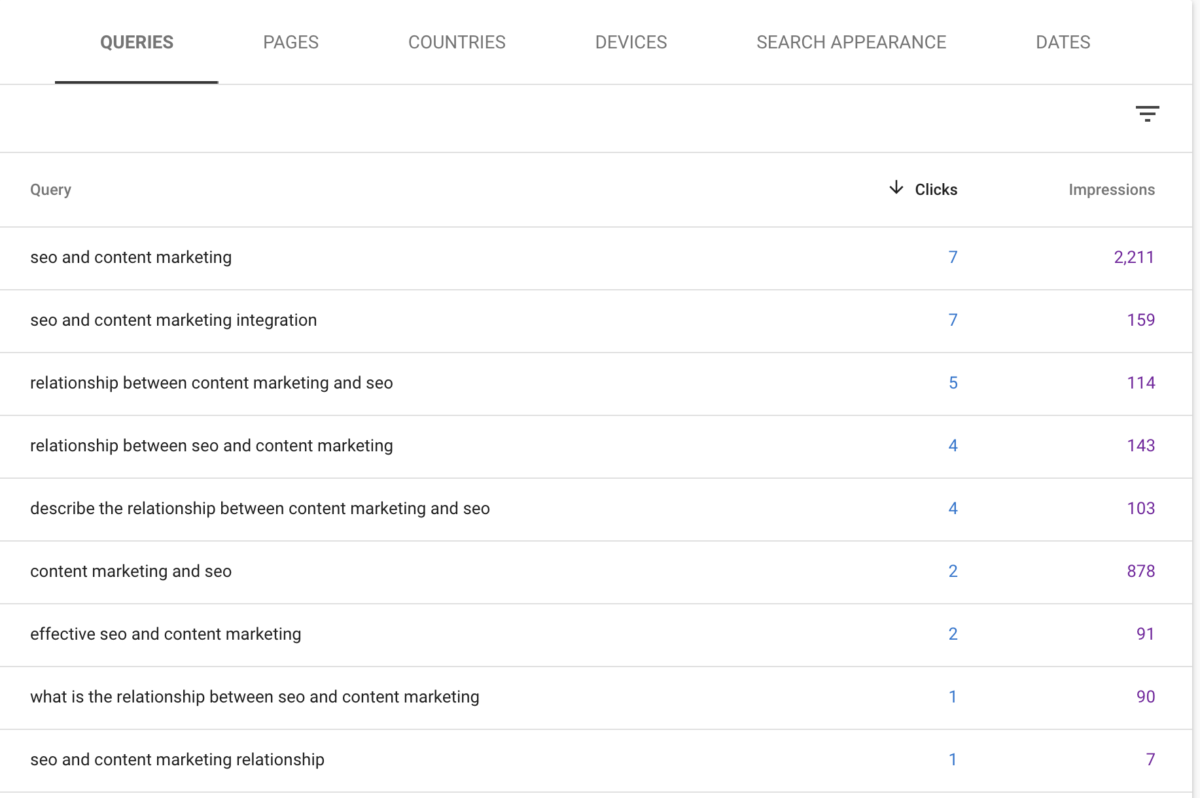
Conclusion
The relationship between content marketing and search is important. But, all too often, it’s been considered as a lower level B2B marketing tactic by content teams.
But we believe search plays a pivotal role, from high-level strategy to the day-to-day business, of every effective content marketing performance strategy. We just need to integrate the processes at every stage possible.
Let us know if you agree.

Enjoyed this article?
Take part in the discussion


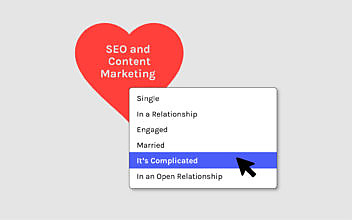





Comments
Sarah Mitchell Typeset August 17th, 2020
Thanks for breaking this down so succinctly, Neil. SEO continues to confuse, something that was proven in our State of Writing research. We found search is not a priority for business communicators and attention to SEO was surprisingly low even though the majority of respondents say they’re publishing most, if not all, of their content online.
Neil Stoneman August 17th, 2020
Hi Sarah,
Yes, it’s always been a tough one. Integrating a technical process with a creative one is way more, well, complicated than it looks. What we find is creative is the key but SEO grows in importance with clients over time. After a while they expect this to be a dial that moves.
Where can we check out the report?
Sarah Mitchell Typeset September 11th, 2020
Hi Neil,
I’ve written about the specific finding of our research here: https://typesetcontent.com/blog/writing-for-seo-is-a-struggle/. I’ve also linked to this article in the post because you’ve done such a good job of detailing the complexity.
Thank you!
Doug Kessler September 28th, 2020
Thanks, Sarah! Great post.
Riya Mathur DiscoverWebTech Pvt Ltd August 24th, 2020
Hi Neil! Informative blog! SEO includes developing quality links back to your website. Content marketing is absolutely the best method to pull inbound links from readers and SEO doesn’t work without good content! The relationship between the two is reciprocal. Thanks for sharing valuable information.
Nanda Treinamento Digital October 13th, 2020
Great job, Neil. It is really important to understand this relationship. Thanks for sharing your knowledge!
Sandra Stauffer Watch Wish November 12th, 2020
we sold our products through content marketing its best way
sameer mohd sam May 11th, 2021
Content groups or “centers” can be a fruitful method to make and transfer content, regardless of whether the aim is conditional or instructive.